|

by Ken Jeremiah
November 09, 2024
from
AncientOriginsUnleashed Website

Open Book Photo
Public Domain
Thinking
Critically
about
Myths and
Legends...
A legend is a tale regarded as historical even though it has not
been proven, and the term "myth" can refer to common yet false
ideas.
Many myths and legends describe our history,
but they are often treated skeptically.
This is because many of them, while explaining a
phenomenon, involve divine or supernatural beings.
However, despite the fact that many disbelieve
such stories, they do not disappear; they are passed down to future
generations.
Some parents tell their children that the stories are
true.
Others explain that they are likely untrue but
important.
And for human beings, they are significant...
Needing to Know
Psychologically, humans despise ignorance, even though
they do not know much about planetary history...
Nevertheless, due to this psychological need,
historical accounts (which function in the same manner as myths) are
filled with what the top minds (at the time) believe are the most
logical course of events, and then their suppositions are treated as
facts and taught to children.
This leads to children believing that certain
hypotheses are facts, and if a teacher who can think critically
questions those facts, the students often have a psychological
aversion to the topic.
They need to "know" what occurred.
If history textbooks contained empty sections in
which the author stated,
"We are not certain what occurred during this
time," students would likely be insecure because "knowing" what
happened provides security.
Myths and legends fill in
knowledge gaps.
People want to know what they do not know, and
myths thereby provide comfort. They are happier on a calm sea than
an agitated one.
However, people's reliance on myths have
distorted their historical views, and such myths are so much a part
of their psychological makeups that questioning them is threatening:
they will lash out and do anything they can to stop their beliefs
from shattering...
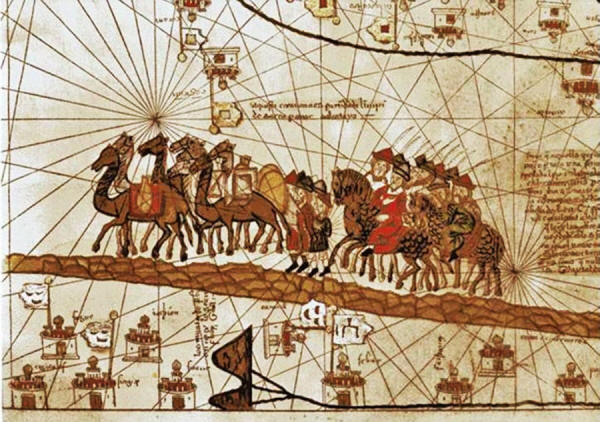
The caravan of Marco Polo
traveling
towards the Indies.
Illustration c.
1375
(Public Domain)
Mention that an individual named Marco Polo who went to China
in the 1200s likely did not exist and people will get angry.
They will lie and use deceit to try to prove he
existed, even though outside of one book written by the fiction
author
Rustichello da Pisa, there is no evidence of his
existence.
What is it about people that makes his existence
important?
It is the desire to "know" history, and
because of this need, willful blindness appears.
Similarly, evidence exists that suggests human
beings are millions of years old, but since this is not the history
most people learned in school, they are generally opposed to it.
Because of such opposition, views of history are
distorted, likely untrue, and ethnocentric.
How could
Christopher Columbus have discovered the Americas if
there were already millions of people there?
Most students don't even know what he was
called (Colón), despite the fact that some countries' money is
named after him (colónes)...
Similarly, students will learn some basic
information about Chinggis or Genghis Khan but never
learn his name (Temujin).
These are just some basic examples of a much more
widespread problem:
history is misleading and, quite literally,
chosen for inclusion in history books.
Facts that do not support the widespread view of
historical events on this planet are discarded and even ridiculed.
Some archaeologists have even publicly stated
that if the evidence does not fit the established theory, it must be
discarded.
The Truth of History
As a result, the majority of citizens are stuck in a rut, and they
find it difficult to consider alternative historical possibilities.
The only way to fix this problem is for people to
assume that many historical events are distorted, even unknown, and
then try to see things anew.
The great
Dao De Jing (Tao
Te Ching) informs us that when
great people perceive the truth (or Way), they will study it and
never stop.
Mediocre people will pursue it for a bit
and then forget it, while inferior people, upon hearing about
the truth, will laugh aloud, and if they did not laugh, it would not
be the truth.
Astounding Ancient Engineering in
Egypt
The following historical accounts should be seriously reconsidered
to establish a more accurate view of planetary history:
Numerous megalithic sites defy mainstream
explanations.
Human beings created such structures, and today,
even with our modern technological advances we cannot duplicate
their achievements.
Such structures include the
Great Pyramid in Egypt, insofar as its creation and
precision.
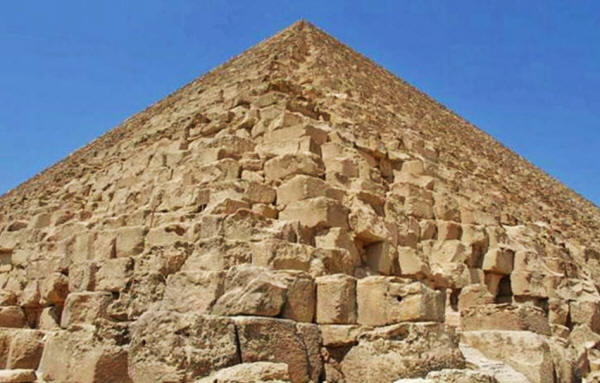
The Great Pyramid of Giza.
(Mgiganteus1/CC
BY-SA 3.0)
Between 2.3 and 2.6 million white limestone blocks weighing between
two and 15 tons each were moved across great distances and cut with
laser-like precision.
They were then stacked to create a highly
polished, shiny pyramid.
Moving such weights more than 100 feet into the
air would prove difficult and dangerous today, yet the pyramid's
builders were able to do so with astonishing precision and (if
the Egyptologists' consensus of a 20-year building process is
correct...) speed.
If workers labored 10 hours every day,
yearly, without a single day's break, and provided that there
were no errors or accidents that set them back, they would have
to move 31 perfectly-cut blocks into the mathematically precise
positions every hour.
This is not possible today, so we have no
idea what technology was used in its creation.
We also do not understand how the blocks were
moved and lifted, because every theory involving ramps and cranes is
discredited if weights and numbers alone are considered.
When Christopher Dunn explored the Temple of Amun Mut
Khonsu he noticed that all the statues of Ramses were identical:
the faces' left sides were exactly the
same as the right ones.
After using computer graphics and drafting tools,
he wrote,
"It becomes clear that the statues must have
been cut with the assistance of mechanical devices that caused
the cutting tool to move along predetermined boundaries to
produce an accurate representation in granite of the specific
design".
Their very creation makes them out-of-place
artifacts...:
they do not neatly fit into the mainstream
historical record.
Therefore, a new history should be considered:
one that takes into account all anomalous
finds.
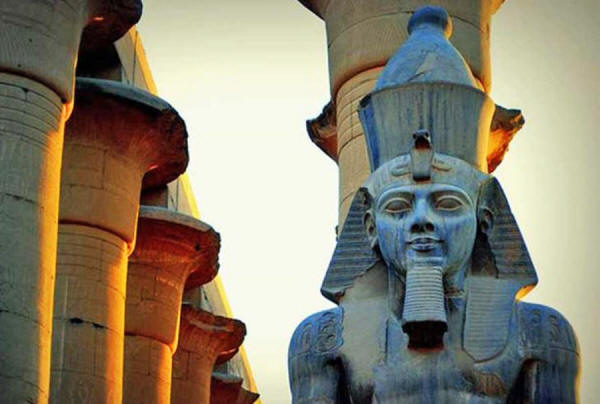
Statue of Ramses II
at Luxor Temple,
Egypt.
(CC BY-SA 4.0)
Other structures in Egypt, including
the Sphinx, which has tantalized archaeologists and
historians for years, were likely built c. 10,500 BCE even though no
historical texts used in schools would ever suggest that fact.
According to what has occurred in modern
Egyptology, if evidence supports established theories, it will
be accepted, but if it undermines them, it will be rejected.
Mysterious Ancient Builders of
Peru
Another amazing site is
Sacsayhuaman in Cusco, Peru, which
the Incans claim they did not build but mainstream archaeologists
and anthropologists insist that they did.
When the fortress walls were built, giant
boulders weighing more than 200 tons were quarried from a site 1,500
miles (2400 km) away, maneuvered over mountains, and then carved on
site to fit perfectly with other megalithic stones in a puzzle-like
interlocking pattern.
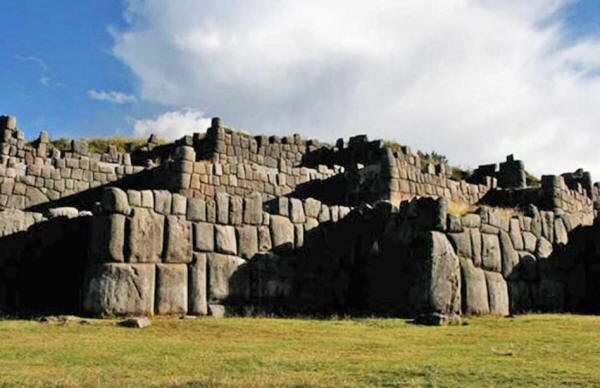
Sacsayhuamán,
situated to the
north of Cusco, Peru.
(Public Domain)
Some of the blocks weigh more than 360 tons.
Today, such-sized stones could be moved by
heavy-lift cranes, but not up and down mountains without roads.
Another inexplicable oddity about the stones is
that the ones at the fortress have perfectly consistent textures
with no imperfections or micro-skeletons, despite the fact that
others at the quarry from which they came do have such
imperfections, as do most sedimentary rocks.
Finally, the stones show evidence that they were
once subjected to temperatures as high as 1100 degrees centigrade
(Hancock, 2015).
This perhaps leads some credence to the Incan and
European accounts that the stones were actually liquefied and then
poured into molds:
an ancient form of concrete...
Unbelievable Ancient Feats in
Lebanon
The ancients' similar skills are seen in the construction techniques
of other megalithic sites, including the
Temple of Jupiter in Lebanon.
Three particular stones weigh approximately
1,200 tons.
Moving them today would require 21 heavy-lift
cranes working in unison.
Of course, there is no way to maneuver 21 of them
around the same object with the necessary counterweights and yet
have them all work together and move in the same direction.
Yet, the ancients seemingly had no problem
accomplishing such feats.
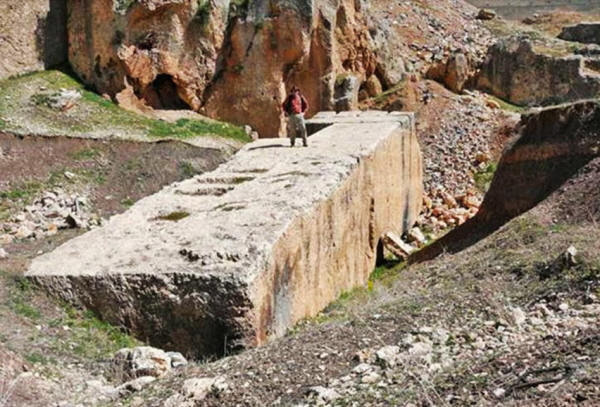
Ralph Ellis
stands on the
largest quarried
stone at
Baalbek,
Lebanon.
(CC BY-SA 4.0)
Early European
Colonies Dispute Columbus Story
Consider megalithic structural designs and historical accounts and
it becomes clear that something is missing in our perception of
history.
Returning to Christopher Columbus and how
he could not have discovered the New World because,
they were already millions of people there,
someone might argue that his appellation is apt because he was
the first European to arrive, but to make such an assertion,
such people have to disregard evidence that contradicts their
view:
evidence that Europeans were in North
America in the 1300s and that Templar colonies were also
there.
One such colony was most likely in Newport,
Rhode Island.
More evidence that history is ethnocentric is found
just by looking at history books.
How many American History texts are based on
Native Americans? (They generally center upon the Europeans who
came to the Americas instead.)
And how many people know that Native
Americans traveled by boats to Europe at approximately the same
time Europeans first traveled to America?
Similarly, cocaine and hashish were
found in ancient Egyptian mummies, and recent tests demonstrate that
the substances were ingested.
Since mainstream historical accounts hold that
Egyptians did not go to America and the Americans did not travel to
Egypt, it is a dangling, inconvenient fact that they have not
yet been able to comprehend.
Doesn't intercultural communication on a
worldwide scale in the ancient world make more sense...?
Going Forward by Questioning
Historical Myths
The only thing people should do to think critically is to keep an
open mind and stop (mentally) discarding historical finds.
This is difficult, as non-conforming ideas
are typically discouraged.
In classrooms, students are rarely presented with
contradictory information or alternative historical accounts.
They do not generally read, for example,
accounts of Columbus in which he is depicted as a
slave trader, or accounts of the Hiroshima
holocaust written by Japanese survivors...
This is because such inquiry threatens the
established social order.
Hufford wrote,
"A teacher should be encouraged to doubt, to
recognize and build upon discontent, and to actively question,
rather than passively accept, officially-sanctioned, transmitted
knowledge...".
Such questioning might be considered radical, but
it can lead to forward progress.
Let's charge ahead...!
References
-
Cremo, M. & Thompson, R. The Hidden
History of the Human Race. Los Angeles, CA: Bhaktivedanta
Book Publishing, Inc., 2008.
Cremo, M. Forbidden Archaeology's Impact. Los Angeles, CA:
Bhaktivedanta Book Publishing, Inc., 1998.
―.
Forbidden archaeology: The hidden
history of the human race. Los Angeles, CA:
Bhaktivedanta Publishing Company, 1996.
—.
The Giza Power Plant: Technologies
of Ancient Egypt. Rochester, VT: Bear &
Company, 1998.
―. Underworld: The Mysterious Origins
of Civilization. New York, NY: Three Rivers Press, 2002.
―. Magicians of the Gods: The Forgotten Wisdom of
Earth's Lost Civilizations. New York: St. Martin's
Press, 2015.
-
Hein, L. & Selden, M. Censoring history:
Citizenship and memory in Japan, Germany, and the United
States. New York: Sharpe, 2000.
-
Hufford, D. Teacher education,
transformation, and an education for discontent. Journal of
Philosophy and History of Education, 58, 83-91, 2008.
-
Jeremiah, K. Understanding Approaches to
Teaching Critical Thinking in High School Classrooms.
ProQuest LLC, Ed.D. Dissertation, Walden University, 2012.
―. Remnants of a Distant Past: A New
Theory to Explain the UFO Phenomenon. South Carolina:
CreateSpace, 2013.
―. Eternal Remains: World Mummification and the Beliefs
that Make It Necessary. Sarasort, FL: First Edition
Designs, 2014.
―. Is Marco Polo a Fictional Character? Ancient-Origins
(subscribers' section), 2016.
―. Thinking Critically About Time: A Cyclical View.
Ancient-Origins (subscribers' section), 2016.
-
Nickerson, R. S., Perkins, D. N., &
Smith, E. E. The Teaching of Thinking. Hillside, NJ:
Erlbaum, 1985.
-
Sora, S. The Lost Colony of the Templars:
Verrazano's Secret Mission to the Americas. Rochester, VA:
Inner Traditions, 2004.
―. The Micmacs and the Picts: Distant
Cousins? In Exposed, Uncovered and Declassified: Lost
Civilizations and Secrets of the Past (Edited by M. Pye
and K. Dalley). Pompton Plains, NJ: Career Press, 2012.
|







